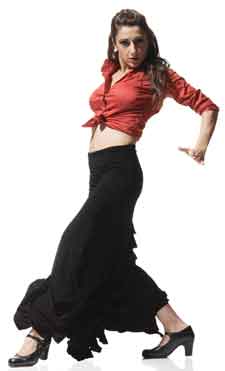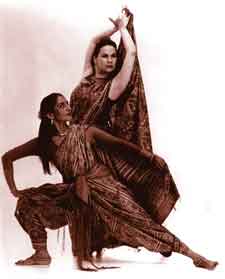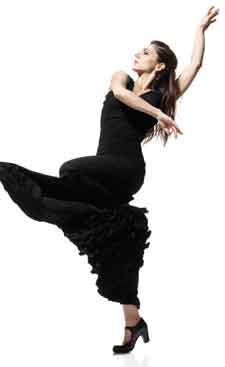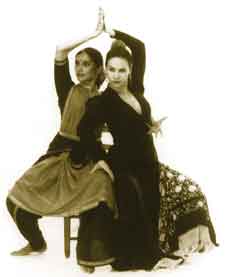Arts
The Fusion Of Flamenco Natyam

Flamenco returns to its Indian roots.
A skirt’s ruffle swirls in a smoky bar’s haze. Percussive feet punctuate the sound of melancholy guitars. The scene is commonplace sight in Madrid’s many flamenco bars, but tonight’s show is some 5,000 miles away from Spain, in one of Delhi’s swankier hotels. At first blush, this Spanish dance seems alien to its Delhi audience. But tonight’s dancers are performing in a city that, unbeknownst to many, is close to flamenco’s original Indian roots.
Flamenco is commonly associated with the sultry landscape of southern Spain. But the songs that are the roots of flamenco are believed to come from the arid plains of northern India. Although there is little consensus among historians on the origins of flamenco, many trace it to a group that migrated from north India across Europe some 1,000 years ago. This nomadic group called itself the Roma, although they are often dubbed “gypsies” in Spain, where some Roma eventually settled. The Roma had few material possessions, but one unique tradition survived the journey from India: their song and dance. Inevitably these songs mixed with local folk traditions. The result is modern flamenco, whose link to India is apparent in the rhythms and movements. The connection between flamenco and classical Indian dance was nonetheless unexplored by dancers until recently. Flamenco flourished in Spain during the late 19th century in tablaos, or cafes. But a wane in its popularity coincided with a politically authoritarian regime in Spain under which the arts, including flamenco, languished. Only after democracy was restored did flamenco reemerge. Flamenco has only recently begun to interact with other dance forms and experiment with new movements as it evolves from traditional dance into high art. Now as part of today’s cutting-edge global dance trends, preeminent Spanish and Indian dancers are exploring their little-known, but shared history in fusion dance performances across the world.
New York based flamenco dancer and singer La Conja has always had an attraction to flamenco’s eastern roots after noticing similarities while performing across the world, and because of her Egyptian background. Knowledgeable about flamenco’s history, she approached musician Pedro Cortes about a collaboration exploring flamenco’s India history. La Conja did not, however, want to merely add an Indian instrument or don an exotic costume. Instead, she sought to create a production that would fuse both the music and dance of flamenco and Indian Carnatic styles. She hoped to create pieces that highlighted the similarities of both dance and singing forms through intertwining duets. She approached Rajika Puri, an accomplished Bharat Natyam and Odissi dancer, who had become a flamenco afiocionada after falling in love with it over 40 years ago. Because both dancers had intermittently studied each other’s styles of dance throughout their respective dance careers, La Conja and Rajika had the solid foundation of dance knowledge to produce the show. The result of their collaboration in 1997 was the productionPani, which translates to “water” in both Hindi and Calo, the language of the Roma. The production was a duet performance set to flamenco guitar and sitar. Pedro Cortes served as musical director for the production. During performance, he was able to create an entirely new flamenco sound by building unusual harmonies and working on intricate rhythms for his guitar that are usually the foundation of sitar music.
The dancers used the performance as a way to explore the similarities of flamenco and Bharat Natyam, a traditional south Indian dance. Hand gestures, footwork, rhythm and melodies were all intertwined so that the link between flamenco and Bharat Natyam would be clearly communicated to the audience. For example, flamenco and Bharat Natyam both use foot and arm work to communicate different emotions. La Conja and Rajika wove their movements so that they sometimes performed the same sequence, but in their respective styles portraying similar emotions. They both also incorporated another common element of flamenco and Bharat Natyam: improvisation. Dancers and musicians in both styles are almost always playing to each other without rigid choreographies, utilizing rhythmic cues to guide each other. Consequently, each performance is truly unique. The rousing success of this innovative production led to an invitation to the ensemble to perform their production titled “Flameno-Natyam” in January 1998 at the Guggenheim Museum in New York City, followed by a two-month tour across India. After the tour, La Conja and Rajika continued to pursue their interest in “fusion” dance art. In 2000, Rajika presented “Sacred River,” featuring south Indian singer Aruna Nairam, guitarist David Serva, and dancer Clara Mora. More recently, she was invited to prepare a new solo in 2005 titled “TauroMagica Suite,” or “Bull Magic Suite,” which she debuted at the Kala Ghoda Festival in Mumbai. La Conja, too, has continued to perform various “Flamenco-Natyam” pieces while expanding her fusion repertoire to include elements of other eastern traditions. Her latest project is the development of an entirely new dance style she calls “Natajara Flamenco,” which blends the two styles of Bharat Natyam and Flamenco with a unique set of movements. The success of these performances in India has both astounded and inspired other fusion artists. “Flamenco is not a dance routinely performed in India and you never know how audiences will respond, particularly since Bharat Natyam is in essence a sacred art,” Rajika says when discussing the preparation for the “Flamenco-Natyam” tour in India. “But the audiences were excited to see the something entirely new performance and they are becoming more open to experimentation with tradition.”
The Indian Council for Cultural Relations sponsored the filming of a fusion flamenco and Kathak show in Delhi performed by renowned artists Omayra Amaya and Shovana Narayan in 2003. Omayra, grandniece of legendary flamenco artist Carmen Amaya, has always been attracted to exploring new dimensions to flamenco dance and is known for her innovative style that routinely draws from modern and jazz movement. She was immediately attracted to the idea of creating a collaborative work in India when Shovana approached her about the production. “It was a challenge to work quickly and try to blend two styles that are both so rich and complex in terms of their rhythms and expression,” Omayra says, “but it is gratifying to push flamenco forward in this way.” As a Kathak dancer, Shovana, too, is inspired to push Kathak in new directions by often creating collaborations with other world-renowned artists. Fusion performances are particularly appealing to younger audiences, who are increasingly exposed to so many dance styles and indeed have come to expect creativity in performance. In India, they have grown accustomed to Bollywood dance sequences that borrow widely from hip-hop, modern, salsa and other dance styles. For many Indian Americans, fusion performances are a hreflection of their own hybrid cultural background where American, Indian and other cultures routinely mix. And even for audiences without any direct connection to India or Spain, the fusion performances represent a trend of cultural experimentation that offers excitement and a hrefreshing twist on traditional styles. When asked what motivated her to pursue various flamenco fusion works during the past 10 years, Rajika responds that she is inspired by how seemingly diverse audiences nevertheless all relate to the themes present in Bharat Natyam and flamenco, like love, loss and devotion. To her, the form of dance is less important, whether modern, fusion, or traditional, than the communication of pure emotion with the audience. “Flamenco-Natyam gives the audience the chance to experience not just one, but two art forms with rich traditions,” Rajika says, “so my hope is that they can draw twice the emotional experience from immersion in these two great forms.” |




